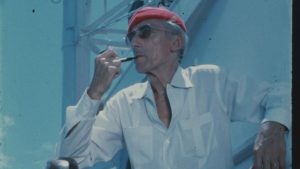
If you grew up in the middle of the 20th century, the first view you ever had of the undersea world and the animals who live there was via the TV specials of Jacques Cousteau. He had started making movies there in the 1940s, with one of them, “The Silent World,” winning the Palme d’Or at Cannes and an Academy Award, too.
But it wasn’t until 1967, when ABC aired the 12-part series, “The Undersea World Of Jacques Cousteau,” that most of us got an up-close look at sharks and other marine animals and reefs. The series had an average viewership in the US of 26 million, and was also seen on 100 networks around the world. It made him a star.
Now comes a documentary about Cousteau’s life. By the way, that’s not a word he ever applied to his work. He didn’t consider himself as a documentarian, but rather a man who made action films. He was also an inventor, one of the three men who developed the aqualung, modifying existing technology in the late 1930s and early 1940s to come up with an underwater breathing device with air tanks on the back — the precursor to scuba gear.
In the early part of his career, thanks to that equipment which allowed divers to go deeper than they had before, Cousteau was hired by petroleum companies drilling for oil and helping maintain underwater equipment. He used the money he earned to fund his ship, The Calypso, on which he traveled the world exploring and filming. But he later disavowed that work after seeing the ecological impact of drilling, dumping, and industrial waste on the oceans. He adapted his message and spent his last couple of decades speaking out on behalf of protecting the world’s water.
Children especially responded to Cousteau’s film, and flocked to see him when he made in-person appearances. The documentary captures the awe in their eyes and the smiles on their faces just from hearing him talk about his adventures.
My single complaint about “Becoming Cousteau” is that the subtitles are too small and not very well contrasted, with white fonts that get washed out in some of the scenes. That’s a shame, because while Cousteau was fluent in English, many of his colleagues who spoke to director Liz Garbus are not. It’s also interesting to note how other nature documentarians (e.g. David Attenborough) have followed in his footsteps, albeit with far better equipment and even more dazzling photography.
Still, “Becoming Cousteau” captures the essence of his life, both personal and professional, and serves as a reminder of how important he was in opening the eyes of millions to a world very few got to see up close. It includes plenty of footage from Cousteau’s projects, some unseen until now, as well as excerpts from his journals and articles.
My favorite Cousteau quote, included in the movie, is when he was asked by a TV interviewer why he would want to go to sea when he could learn all about it from books and museums. Cousteau’s response: “You could read a book about lovemaking, but it doesn’t compare.”
I give “Becoming Cousteau” a 9 out of 10. Opens in theaters tomorrow.
